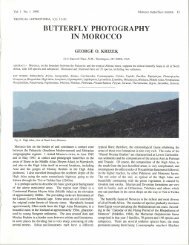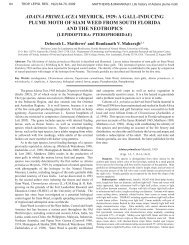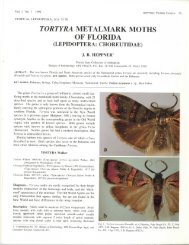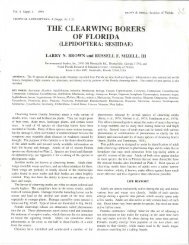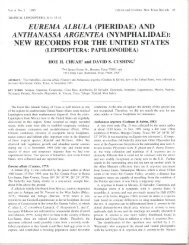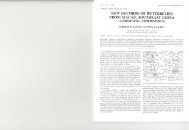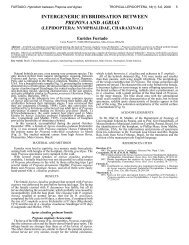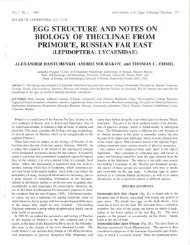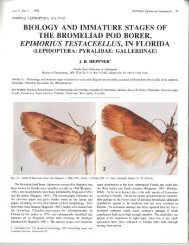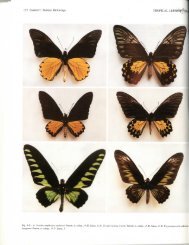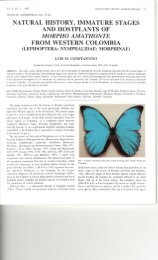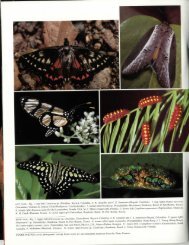A NEW SUBSPECIES OF PARIDES GUNDLACHIANUS FROM CUBA
A NEW SUBSPECIES OF PARIDES GUNDLACHIANUS FROM CUBA
A NEW SUBSPECIES OF PARIDES GUNDLACHIANUS FROM CUBA
You also want an ePaper? Increase the reach of your titles
YUMPU automatically turns print PDFs into web optimized ePapers that Google loves.
Vol. 6 No. 1 1995<br />
HERNANDEZ, ALA YON and SMITH: Parides gundlachianus Subspecies 15<br />
TROPICAL LEPIDOPTERA, 6(1): 15-20<br />
A <strong>NEW</strong> <strong>SUBSPECIES</strong> <strong>OF</strong><br />
<strong>PARIDES</strong> <strong>GUNDLACHIANUS</strong> <strong>FROM</strong> <strong>CUBA</strong><br />
(LEPIDOPTERA:<br />
PAPILIONIDAE)<br />
LUIS R. HERNANDEZ1, GIRALDO ALAYON-GARCIA1<br />
and DAVID SPENCER SMITH2<br />
'Museo Nacional de Historia Natural, Capitolio Nacional, Ciudad de la Habana 10200, Cuba; and<br />
2Hope Entomological Collections and Dept. of Zoology, University Museum, Parks Road, Oxford OX1 3PW, England<br />
ABSTRACT.- A new subspecies of the endemic Cuban swallowtail butterfly, Parides gundlachianus C. Felder & R. Felder, is described, P. g. alayoi<br />
n. subsp., from a western locality, in Pinar del Rio Province. Field observations on the behavior and habitats of these populations and in centers of<br />
abundance of the typical insect in eastern Cuba are described. Variation in adult size is recognized as an altitudinal cline. Biogeographical aspects<br />
of this and other Cuban papilionids are discussed, and the need for conservation and protection of the western populations is stressed.<br />
KEY WORDS: altitudinal cline, Araneae, Argentina, Aristolochiaceae, behavior, biogeography, biology, Bolivia, Boraginaceae, Brazil, Caribbean,<br />
Compositae, conservation, Cuba, distribution, Leguminosae, Mexico, Papilio, Paraguay, Parides gundlachianus alayoi n. subsp., population biology,<br />
Reptilia, Verbenaceae, West Indies.<br />
The New World papilionid genus Parides Hiibner includes<br />
some 45 species (D'Abrera, 1981) ranging from Mexico through<br />
Central and South America to northern Argentina, Paraguay and<br />
Bolivia, with a center of diversity in Brazil. In addition, subspecies<br />
have been described for almost half of these, raising the total<br />
of Parides taxa to over one hundred. It is represented in the West<br />
Indian biogeographical zone by only a single, and very distinctive<br />
species, endemic to Cuba.<br />
This swallowtail, now known as Parides gundlachianus, was<br />
described by Herrich-Schaffer (1862) as Papilio columbus, a<br />
pre-occupied name that Felder and Felder (1864) replaced by<br />
Papilio gundlachianus. In 1865, Blake described the same insect<br />
as Papilio grotei, a name that passed into synonymy. Gundlach<br />
(1881) knew this beautiful butterfly as inhabiting "the eastern part<br />
of the island of Cuba, and has been seen there at Cabo Cruz, in<br />
the highlands to the south of Bayamo, at Brazo del Cauto, at El<br />
Cobre and at the coast at Santiago de Cuba." Torre (1971)<br />
introduced the name 'calzadillae' for specimens generally referred<br />
to by Cuban entomologists as the 'mountain form' of the<br />
butterfly, found on the highest eastern peaks and appreciably<br />
larger than those from lowland localities. Riley (1975) placed this<br />
species in the genus Parides Hiibner, a course followed by Alayo<br />
and Hernandez (1987) who also, for the first time, reported a<br />
population of P. gundlachianus from western Cuba, and placed<br />
the form described by Torre under synonymy. In this account, a<br />
new subspecies of P. gundlachianus is described, the 'mountain<br />
form' is considered further, together with ecological, ethological<br />
and distributional aspects of the biology of this butterfly.<br />
In preparing this account, we have examined the following<br />
collections: the Institute of Ecology and Systematics of the<br />
Academy of Sciences of Cuba (CZACC); the 'J.H. Pazos group'<br />
of San Antonio de los Banos (CJHP) in care of Adalberto Leon<br />
and Pedro A. Rodriguez; Fernando de Zayas (CFZ); the National<br />
Museum of Natural History, La Habana (MHNC), and the collection<br />
of the senior author (CLRH). Alar index (wingspan) was<br />
measured with a millimeter scale as twice the mid-point of the<br />
thorax to the forewing apex; this morphological character was<br />
selected from others as the best indicator of variability. For clinal<br />
analysis, specimens were collected at three altitudinal zones:<br />
sea-level, between 200m and 800m and above 900m. Material on<br />
which the new subspecies is based was obtained during seven<br />
visits to the type locality. Genitalic preparations were made<br />
according to Alayo and Hernandez (1987).<br />
Parides gundlachianus alayoi<br />
Hernandez, Alayon & Smith, n. subsp.<br />
(Fig la-b, 9)<br />
Diagnosis.- In the nominate subspecies the white spot on FW<br />
underside is more or less rectangular, though variable in width<br />
(Fig. 2-3), elongate, arising broadly against the costa, truncate at<br />
its end (very rarely pointed), touching and sometimes extending<br />
slightly beyond the vein linking M3 and Cu,. Genital harpe with<br />
posterior and anterior teeth less pronounced, the latter extending<br />
further along the lateral margin (Fig. 10).<br />
Description.- MALE: very similar in form and coloration to the<br />
nominate subspecies P. g. gundlachianus, from which it differs in shape<br />
of the white spot on the underside forewing (Fig. Ib) which is spindleshaped<br />
or almost triangular. It arises just below the costa near center of<br />
the wing, crosses much of the discal cell and tapers to end sharply above<br />
center of the vein joining M, and Cu,, without touching it. The red distal<br />
spot on the HW upperside between M, and M2 is faint or absent. The<br />
fold at the HW anal margin is as in P. g. gundlachianus. Genitalia:<br />
harpe with teeth at posterior and anterior tip more grouped and more<br />
pronounced than in nominate subspecies (Fig. 9).<br />
FEMALE: similar; HW with a well marked distal spot between M, and<br />
M2.<br />
Type locality.- Pan de Aziicar, La Pimienta, Pons, Matahambre, Pinar<br />
del Rio Province, Cuba.
16 HERNANDEZ, ALAYON and SMITH: Parides gundlachianus Subspecies TROPICAL LEPIDOPTERA<br />
Fig. 1-8. Parides gundlachianus alayoi n. subsp.: 1)
Vol. 6 No. 1 1995 HERNANDEZ, ALAYON and SMITH: Parides gundlachianm Subspecies 17<br />
Fig. 9-10. Male genitalia: 9) Parides g. alayoi; 10) Parides g. gundlachianus.<br />
Types: Holotype
18 HERNANDEZ, ALAYON and SMITH: Parides gundlachianus Subspecies TROPICAL LEPIDOPTER<br />
in places includes tall stands of the the cacti Pilocerus and<br />
Dendrocereus, and extends over wide areas of southeastern Cuba.<br />
When visiting flowers (Fig. 8), the butterfly scarcely alights,<br />
the fore-wings moving constantly and rapidly as it passes jerkily<br />
from one inflorescence to the next. Flowers either white or<br />
approaching the butterfly in color seem to be preferred; red or<br />
blue-toned. Lantana camara (Verbenaceae) and Eupatorium<br />
odoratum (Compositae) are often visited by subspecies P. g.<br />
alayoi but, as with many butterflies, nectaring is often opportunistic;<br />
at Sardinero we have seen adults feeding in tall trees of<br />
Pithecellobium unguis-cati (Leguminosae), occasionally at ground<br />
level on Bidens alba (Compositae) and at Jauco a white-flowered<br />
Bourreria (Boraginaceae) tree was the most abundant nectar<br />
source at the time of our visit. The undisturbed flight is quite<br />
slow and gentle, but swift and direct when the butterfly is<br />
alarmed.<br />
The type locality of the newly described subspecies lies in the<br />
northern part of the Vinales valley, an area of remarkable scenery<br />
(Fig. 5), dominated by steep mogote hills arising from the flat<br />
valley floor, long intensively cultivated, notably for tobacco. The<br />
hills are densely forested, precipitously contoured and support<br />
many endemic plants. Here, the butterflies roost high in the<br />
forest, move in leisurely flight above the canopy to low nectaring<br />
sites within or outside the forest in the morning, retracing their<br />
path late in the afternoon. This general pattern of behavior is<br />
shared by eastern populations, where localities also include hill<br />
and mountain slopes, and lower land rich in flowers.<br />
PREDATION<br />
In common with other Aristolochia-feeding swallowtails, P.<br />
gundlachianus has been viewed as distasteful to predators, and its<br />
slow flight and brilliant coloration as aposematic features. No<br />
wing damage suggestive of unsuccessful bird or lizard attack has<br />
been noted in museum series of either subspecies, or in specimens<br />
we have collected. Several butterflies were found in Nephila<br />
clavipes webs near Jauco in June 1993, but spiders were not seen<br />
feeding, though a crab-spider (Misumenops sp.) was found there,<br />
apparently feeding on a specimen it had captured. We have only<br />
once observed predation by a vertebrate: at an eastern site near<br />
Jauco, an Anolis equestris (Reptilia) was filmed by John Banks<br />
in December 1990 as it ate a captured butterfly (Fig. 6-7).<br />
Ingestion took over 60 minutes, the lizard remaining motionless<br />
for long periods between gulps as the insect's body was taken,<br />
head first, into the mouth. While it is tempting to view the<br />
slowness of the meal as showing the triumph of hunger over<br />
unpalability, this view remains conjectural!<br />
VOLTINISM<br />
The western subspecies appears to be at least bivoltine, flying<br />
mainly from September to May, though annual fluctuations in<br />
adult emergence no doubt occur. It was abundant late in December<br />
1990, while on our most recent visit at the end of March<br />
1994, it was again common and most specimens were either very<br />
worn, or recently emerged. Only two adults were seen when we<br />
visited the type locality in late September 1991, while a few days<br />
later typical P. gundlachianus was abundant at Sardinero, 900km<br />
to the east. The latter seems to be multivoltine and continuously<br />
brooded, flying throughout the year, but adults are perhaps most<br />
common from June to November. Our colleague L. F. de Armas<br />
found it in great abundance, and including pairs in copula 0<br />
May 1 1974 at Loma El Pilon, Mayan, Holguin, and it was on<br />
of the commonest butterflies when we visited Jauco at the end<br />
June 1993.<br />
VARIATION IN SIZE WITH ALTITUDE<br />
On comparing contiguous or neighboring populations<br />
different altitudes, we find that wing span changes regularly an<<br />
progressively. Such progressive variation is characteristicall<br />
clinal; in this instance populations evidently representing a<br />
'altitudinal cline' with form 'calzadillae' representing the upp<br />
range of the scale. Table 1 shows the direct relationship betwee<br />
increase in size with increasing altitude of the population, in bot<br />
sexes. In all populations males have shorter, narrower and mor<br />
robust wings, presumably facilitating greater flight speed an<br />
manoeuvrability during courtship and copulation. It is noteworthy<br />
that no substantial difference is seen between eastern population<br />
(typical P. gundlachianus) from between 200m and 800m abow<br />
sea level and those from Pinar del Rio (subspecies P. g. alayoi<br />
an observation that accords with the position of western popula<br />
tions in the same altitudinal zone as these mid-level easten<br />
colonies. In other words, each population, depending on th<br />
altitude it occupies, maintains a more or less uniform size an<br />
wingspan. No obvious difference is noted between females<br />
eastern coastal populations and specimens from Pinar del Rio,<br />
bu<br />
any conclusion is limited by the small size of our samples of th<br />
sex, which is by far the more rarely seen, in the field.<br />
TABLE 1. Variation in size of adults of Parides gundlachianus<br />
Subspecies P. g. alayoi in Pinar del Rio (PR) and populations of subspecies P.I<br />
gundlachianus in eastern localities (O: Oriente). The latter are grouped in thra<br />
altitudinal levels: s.l. (sea level), -900 (200-800m), +900 (over 900m). Alar mdJ<br />
is measured as mid-point of thorax to forewing apex x2 (for discussion see tex<br />
MALE<br />
FEMALE<br />
PR<br />
O (+900)<br />
0 (-900)<br />
0 (s.l.)<br />
PR<br />
0 (+900)<br />
O (-900)<br />
0 (s.l.)<br />
n Alar Index (mm) x S<br />
22<br />
4<br />
6<br />
25<br />
13<br />
4<br />
6<br />
5<br />
82-92<br />
92-96<br />
82-90<br />
70-84<br />
82-96<br />
100-104<br />
88-95<br />
72-90<br />
86.6<br />
94.8<br />
85.5<br />
77.9<br />
88.8<br />
103.0<br />
92.5<br />
83.2<br />
2.42<br />
1.89<br />
2.81<br />
2.72<br />
4.44<br />
2.00<br />
3.98<br />
6.87 J<br />
DISCUSSION<br />
The swallowtails are represented in the West Indies by son<br />
20 resident species, of which 14 are endemic to the area and fou<br />
strictly confined to Cuba: Parides gundlachianus, Heraclide.<br />
oxynius, H. caiguanabus and Protesilaus celadon. Three specie!<br />
Heraclides aristodemus, H. thoas and Battus polydamas, whew<br />
range extends to the continent and to other islands, are represenl<br />
ed on Cuba by endemic subspecies, and Papilio polyxenes by<br />
possibly extinct Cuban race (Alayo and Hernandez, 1987). Battu<br />
devilliers is primarily Cuban, but also widespread on Andros, I<br />
the Bahamas. The Antillean species Heraclides pelaus and I<br />
andraemon have also evolved endemic forms on Cuba, where A<br />
cresphontes has an uncertain distribution, with occasion!<br />
vagrants of H. troilus and H. palamedes completing the island'<br />
list.
Vol. 6 No. 1 1995 HERNANDEZ, ALAYON and SMITH: Parides gundlachianus Subspecies 19<br />
In this account, we are not considering the possible origins of<br />
the Cuban butterfly fauna, other than noting that while dispersal<br />
has often been viewed as the sole means by which the Greater<br />
Antilles were, and continue to be populated (Brown and Heineman,<br />
1972), others have envisaged a vicariant origin for the<br />
ancestral stock of at least some endemic forms, reflecting tectonic<br />
events in the formation of the islands (Miller and Miller, 1989).<br />
Whatever the means by which Parides first reached Cuba, the<br />
distinctiveness of P. gundlachianus suggests long separation from<br />
continental relatives; at least, from extant members of the genus.<br />
We view the widely separated eastern, and the recently discovered<br />
western populations as perhaps reflecting early fragmentation<br />
of the range of a once widely distributed species, the divergence<br />
between the two present centers representing incipient speciation.<br />
The variation in size with altitude is of secondary significance,<br />
common to both centers but seen as a cline only in the east,<br />
where the butterfly's range passes from lowland localities to the<br />
highest mountain peaks. It is well known that temperature and<br />
rainfall patterns differ markedly between the mountains and<br />
coastal lowlands: in the former the mean temperature is cooler<br />
and relative humidity higher. Ray (1960) suggested that when<br />
individuals of a population are reared at differing temperatures,<br />
those exposed to a colder regime develop more slowly but<br />
eventually reach a greater size. Such may account for the<br />
presence of smaller to larger individuals in species such as P.<br />
gundlachianus, whose distribution covers a wide altitudinal range.<br />
Alayo and Hernandez (1987) mention this effect in the context of<br />
butterflies, and future work may reveal similar altitudinal clines<br />
in other Cuban species.<br />
The wide separation of the two centers of P. gundlachianus is<br />
remarkable in view of the occurrence of Aristolochia throughout<br />
Cuba. However, the coincidence between the distribution of the<br />
butterfly and of several eastern endemic members of the plant<br />
genus, and of 'western' Aristolochia species in the Vinales Valley<br />
is noteworthy. It is possible that the disjunct distribution of the<br />
butterfly is maintained by an ancient hostplant selectivity; a<br />
possibility that will be supported or otherwise, when the life<br />
histories of the two subspecies are fully known. It may be that a<br />
more catholic taste in Aristolochia underlies the wide distribution<br />
of Battus devilliers in Cuba, its presence on the neighboring<br />
island of Andros, and its recent successful colonization of New<br />
Providence (Knowles and Smith, in press).<br />
CONSERVATION<br />
Although the well known nominate subspecies of P. gundlachianus<br />
is not at present under any threat, subspecies P. g. alayoi<br />
occupies only a very restricted area, entirely tied to the mogotes<br />
of the Vinales Valley. Fontenla (1987) recorded a colony in the<br />
same mogote group as the type locality; one was found in similar<br />
terrain a few kilometers to the east, and careful search of the<br />
Vinales area might well reveal additional small colonies. At the<br />
type locality in December 1990, butterflies were plentiful in<br />
flowery, open scrub vegetation, beyond the edge of the mogote<br />
forest, but in March 1994 this area had been lost to cultivation,<br />
and butterflies visited nectar sources within the forest. Any<br />
encroachment of cultivation, or tree felling within the forest<br />
would place its already restricted colonies under further stress. To<br />
prevent its disappearance, we suggest that it should not be<br />
intensively collected, and most importantly that its habitat,<br />
together with its available hostplants, must be preserved without<br />
further change. These measures are needed if a hitherto unrecognized<br />
piece of Cuba's evolutionary history, shown by one of the<br />
island's most beautiful butterflies, is to survive.<br />
ACKNOWLEDGEMENTS<br />
We acknowledge the suggestions offered by Dr. Pastor Alayo<br />
Dalmau throughout this study. We are grateful to colleagues at<br />
the Museo Tranquilino Sandalio de Noda, in Pinar del Rio, for<br />
making available to us the first western specimens and for<br />
information on the location of the population, and to Orlando H.<br />
Garrido for providing literature. Adalberto Leon and Pedro A.<br />
Rodriguez kindly allowed us to examine material in the J. H.<br />
Pazos collection. We thank Reinaldo Carnero for help with<br />
statistical analyses, and our colleague Luis F. de Armas and<br />
specialists in the Departamento de Colecciones, Museo Nacional<br />
de Historia Natural, and Lee and Jacqueline Miller, for their<br />
critical review of the manuscript. We are grateful to John Banks<br />
for assisting us in preparing this account, and for allowing us to<br />
include prints from his film of Parides gundlachianus. Our work<br />
in the type locality was generously supported by a grant from the<br />
RARE Center for Tropical Conservation, Philadelphia.<br />
LITERATURE CITED<br />
Alayo, D. P. and L. R. Hernandez<br />
1987. Atlas de las Mariposas Diurnas de Cuba (Lepidoptera: Rhopalocera).<br />
Havana: Edit. Cientffico-Tecnica. 148pp.<br />
Brown, F. M., and B. Heineman<br />
1972. Jamaica and its Butterflies. London: E. W. Classey. 478pp.<br />
Bonzon, A.<br />
1888. Description of a larva of Papilio gundlachianus two days<br />
previous to its transformation into a chrysalis. Trans. Amer.<br />
Ent. Soc. (Philadelphia), 15:293-294.<br />
D'Abrera, B.<br />
1981. Butterflies of the Neotropical Region. Part 1. Papilionidae &<br />
Pieridae. East Melbourne: Lansdowne. 172pp.<br />
Felder, C., and R. Felder<br />
1864. Species lepidopterorum hujusque descriptae vel iconibus<br />
expressae, in seriem systematicum digestae. Verh. Zool. Bot.<br />
Ces. Wien. 14:288-378.<br />
Fontenla, J. L.<br />
1987. Caracten'sticas zoogeograficas de las ropaloceras (Insecta:<br />
Lepidoptera) de Vinales, Pinar del Rio, Cuba. Poeyana<br />
(Havana), 339:1-11.<br />
Gundlach, J.<br />
1881. Contribution a la Entomologia Cubana. Lepidopteros. Vol. 1.<br />
Havana. 445pp.<br />
Herrich-Schaffer, G. A. W.<br />
1862. Schmetterlinge aus Cuba. Corr.-Blatt Zool. Mineral. Ver.<br />
Regensburg, 16:118-120. 141-143, 156-157, 174-180. [part]<br />
Knowles, D. O., and D. S. Smith<br />
1995. First records of Parachoranthus magdalia (Hesperiidae) from<br />
the Bahamas, and extension of the Bahamian range of Battus<br />
devilliers (Papilionidae). 7. Lepid. Soc. (Los Angeles), 49: (in<br />
press).<br />
Miller, L. D., and J. Y. Miller<br />
1989. The biogeography of West Indian butterflies (Papilionoidea,<br />
Hesperioidea): a vicariance model. In C. A. Woods (ed.),
20 HERNANDEZ, ALAYON and SMITH: Parides gundlachianus Subspecies<br />
TROPICAL LEPIDOPTER<br />
Biogeography of the West Indies, 229-262. Gainesville:<br />
Sandhill Crane Press.<br />
Ray, C.<br />
1960. The application of Bergman's and Allen's rules to the poikilotherms.<br />
J. Morphol. (Boston), 106:85-108.<br />
Riley, N. D.<br />
1975. A Field Guide to the Butterflies of the West Indies. London:<br />
Collins. 224pp.<br />
Torre, S. L.<br />
1971. Mariposas diumas (Lepidoptera, Rhopalocera) colectadas en<br />
Cuba hasta el ano 1969. Ciencias, Cien. Biol. Univ. Habana,<br />
(4) 18:1-47.



